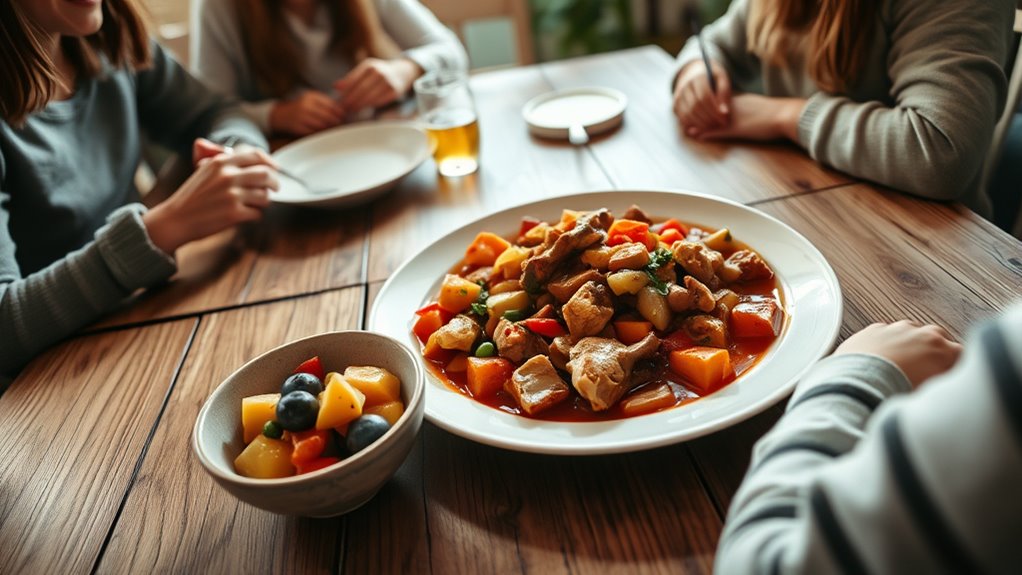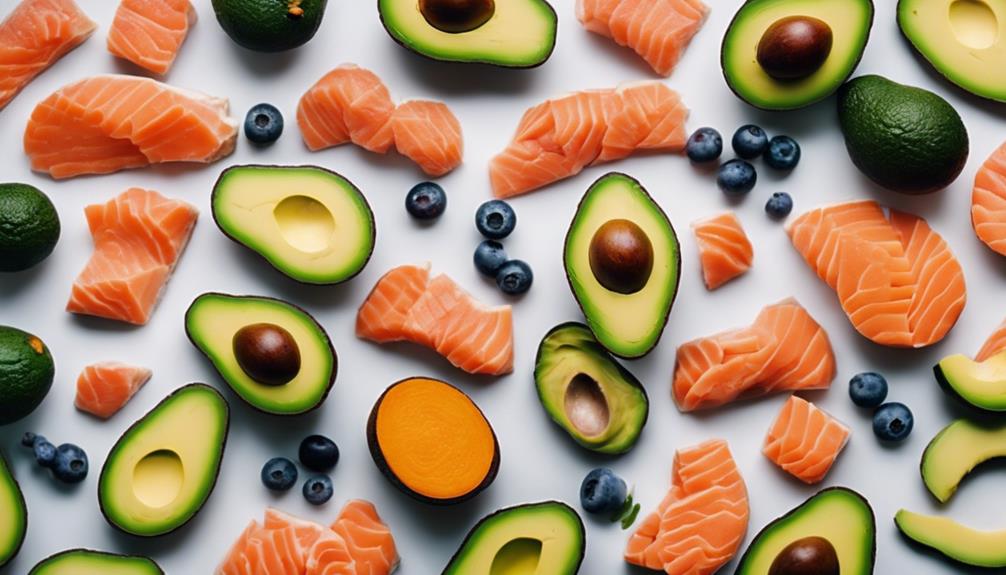Serving one meal for the whole family makes dinnertime simpler and more enjoyable. To adapt your dinner for your baby, prepare a main dish that can be easily divided, setting aside a plain, unseasoned portion before adding seasonings for everyone else. Use safe, soft foods suitable for your baby’s stage, and introduce new flavors gradually. If you want practical tips to make this approach work smoothly, there’s more to discover below.
Key Takeaways
- Prepare a main dish like stew or casserole suitable for all, setting aside a plain portion for the baby.
- Use unsalted, unspiced portions of the meal for the baby to ensure safety and easy eating.
- Gradually introduce new flavors and textures from family meals to support the baby’s developing palate.
- Ensure the baby’s food is appropriately textured and safe, adjusting seasonings and ingredients as they grow.
- Keep a consistent mealtime routine to help the baby adapt smoothly to family dining practices.

Preparing one meal that everyone in your family enjoys can save time, reduce stress, and bring everyone together at the table. When you aim to serve a single dinner for all, it’s essential to consider your mealtime routines and family dining etiquette to make the experience smooth and enjoyable. Establishing mealtime routines helps everyone know what to expect, making mealtime less chaotic and more predictable. For example, setting a consistent dinner time and having a routine of washing hands beforehand helps children understand the importance of cleanliness and readiness to eat. It also signals that family time is about to begin, encouraging everyone to pause their activities and focus on the meal.
Incorporating family dining etiquette into your routine is equally important. Teach your kids to use utensils properly, chew with their mouths closed, and wait for everyone to be served before starting to eat. These small lessons promote respect and good manners, creating a positive mealtime atmosphere. When everyone adheres to these etiquette cues, mealtime becomes a respectful, shared experience rather than a hurried or messy occasion. It also encourages children to develop social skills and understand the importance of courtesy during family gatherings.
Adapting your dinner so that it appeals to a baby alongside older family members requires some planning. You can prepare a main dish that’s suitable for everyone, like a stew or casserole, and set aside a small portion before adding salt, spice, or ingredients that might not be appropriate for your baby. For instance, if you’re making a seasoned chicken and vegetable casserole, keep a little plain portion aside for your baby. This way, you ensure that your little one can enjoy a safe, nutritious meal without extra seasoning or ingredients that could pose a choking hazard. As your baby begins to eat solids, you can gradually introduce more flavors and textures, helping them develop preferences that align with the family’s mealtime routine.
Frequently Asked Questions
When Should I Start Introducing Baby-Friendly Meals?
You should start introducing solids when your baby is around 6 months old, following the baby food timeline recommended by pediatricians. This is the ideal time to begin offering baby-friendly meals, ensuring they develop healthy eating habits early. Keep in mind, every baby is different, so watch for signs of readiness like sitting up and showing interest in food. Introducing solids gradually helps your little one adapt comfortably.
How Can I Ensure the Meal Is Nutritionally Balanced for Everyone?
To guarantee your meal is nutritionally balanced for everyone, consider family preferences and meal planning. Include a variety of food groups—vegetables, fruits, proteins, and grains—to meet everyone’s needs. Balance flavors and textures to satisfy different tastes, and portion appropriately for all ages. By thoughtfully planning and accommodating family preferences, you create meals that nourish, delight, and bring everyone together around the table.
Are There Specific Ingredients to Avoid for Babies?
You should avoid common allergen concerns like nuts, shellfish, and dairy until your baby is older or has been tested. Stick to age-appropriate ingredient selection, focusing on soft, easy-to-digest foods. Keep spices mild and skip honey or choking hazards like whole grapes or hard candies. By choosing safe, suitable ingredients, you protect your baby’s health while ensuring the meal remains nutritious and enjoyable for everyone.
How Do I Modify Spices for a Baby’S Palate?
Imagine your spice cabinet as a garden—some herbs bloom gently, while others burst with intensity. To suit your baby’s palate, you adjust spice mildness by starting with small amounts, like tender sprouts. Gradually, you enhance flavor adjustment, tasting as you go, ensuring the dish remains gentle. This careful nurturing helps your little one enjoy new tastes without overwhelming their senses, building a love for mild, flavorful foods.
What Are Safe Textures for a Baby’S Portion?
You should focus on baby-safe textures that are easy to swallow and avoid choking hazards. Smooth purees, mashed foods, or soft, small pieces work well. These textures let your little one enjoy nutritious family meals without difficulty. As your baby gets older, gradually introduce finer chop or soft-cooked foods to build chewing skills. Always watch for signs of difficulty and confirm the textures are appropriate for your baby’s developmental stage.
Conclusion
By preparing one family-friendly meal, you save time and reduce stress at dinner. Sure, it might seem tricky to accommodate everyone’s tastes, especially your little one’s. But with simple adaptations—like mashing veggies or offering small portions—you can create a meal everyone enjoys. Imagine the ease of sitting down together, knowing you’re nourishing your family without extra fuss. It’s a small change that makes dinnertime smoother and more enjoyable for all.










